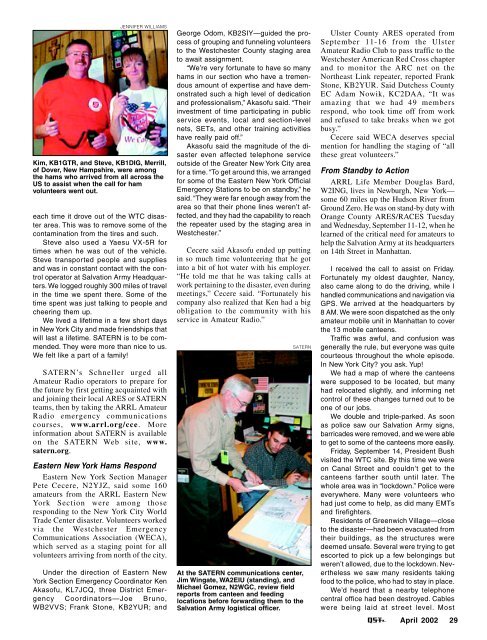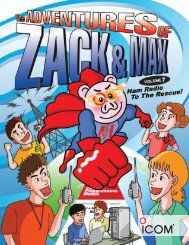SEPT 11 - New York City Amateur Radio Emergency ...
SEPT 11 - New York City Amateur Radio Emergency ...
SEPT 11 - New York City Amateur Radio Emergency ...
You also want an ePaper? Increase the reach of your titles
YUMPU automatically turns print PDFs into web optimized ePapers that Google loves.
JENNIFER WILLIAMS<br />
Kim, KB1GTR, and Steve, KB1DIG, Merrill,<br />
of Dover, <strong>New</strong> Hampshire, were among<br />
the hams who arrived from all across the<br />
US to assist when the call for ham<br />
volunteers went out.<br />
each time it drove out of the WTC disaster<br />
area. This was to remove some of the<br />
contamination from the tires and such.<br />
Steve also used a Yaesu VX-5R for<br />
times when he was out of the vehicle.<br />
Steve transported people and supplies<br />
and was in constant contact with the control<br />
operator at Salvation Army Headquarters.<br />
We logged roughly 300 miles of travel<br />
in the time we spent there. Some of the<br />
time spent was just talking to people and<br />
cheering them up.<br />
We lived a lifetime in a few short days<br />
in <strong>New</strong> <strong>York</strong> <strong>City</strong> and made friendships that<br />
will last a lifetime. SATERN is to be commended.<br />
They were more than nice to us.<br />
We felt like a part of a family!<br />
SATERN’s Schneller urged all<br />
<strong>Amateur</strong> <strong>Radio</strong> operators to prepare for<br />
the future by first getting acquainted with<br />
and joining their local ARES or SATERN<br />
teams, then by taking the ARRL <strong>Amateur</strong><br />
<strong>Radio</strong> emergency communications<br />
courses, www.arrl.org/cce. More<br />
information about SATERN is available<br />
on the SATERN Web site, www.<br />
satern.org.<br />
Eastern <strong>New</strong> <strong>York</strong> Hams Respond<br />
Eastern <strong>New</strong> <strong>York</strong> Section Manager<br />
Pete Cecere, N2YJZ, said some 160<br />
amateurs from the ARRL Eastern <strong>New</strong><br />
<strong>York</strong> Section were among those<br />
responding to the <strong>New</strong> <strong>York</strong> <strong>City</strong> World<br />
Trade Center disaster. Volunteers worked<br />
via the Westchester <strong>Emergency</strong><br />
Communications Association (WECA),<br />
which served as a staging point for all<br />
volunteers arriving from north of the city.<br />
Under the direction of Eastern <strong>New</strong><br />
<strong>York</strong> Section <strong>Emergency</strong> Coordinator Ken<br />
Akasofu, KL7JCQ, three District <strong>Emergency</strong><br />
Coordinators—Joe Bruno,<br />
WB2VVS; Frank Stone, KB2YUR; and<br />
George Odom, KB2SIY—guided the process<br />
of grouping and funneling volunteers<br />
to the Westchester County staging area<br />
to await assignment.<br />
“We’re very fortunate to have so many<br />
hams in our section who have a tremendous<br />
amount of expertise and have demonstrated<br />
such a high level of dedication<br />
and professionalism,” Akasofu said. “Their<br />
investment of time participating in public<br />
service events, local and section-level<br />
nets, SETs, and other training activities<br />
have really paid off.”<br />
Akasofu said the magnitude of the disaster<br />
even affected telephone service<br />
outside of the Greater <strong>New</strong> <strong>York</strong> <strong>City</strong> area<br />
for a time. “To get around this, we arranged<br />
for some of the Eastern <strong>New</strong> <strong>York</strong> Official<br />
<strong>Emergency</strong> Stations to be on standby,” he<br />
said. “They were far enough away from the<br />
area so that their phone lines weren’t affected,<br />
and they had the capability to reach<br />
the repeater used by the staging area in<br />
Westchester.”<br />
Cecere said Akasofu ended up putting<br />
in so much time volunteering that he got<br />
into a bit of hot water with his employer.<br />
“He told me that he was taking calls at<br />
work pertaining to the disaster, even during<br />
meetings,” Cecere said. “Fortunately his<br />
company also realized that Ken had a big<br />
obligation to the community with his<br />
service in <strong>Amateur</strong> <strong>Radio</strong>.”<br />
SATERN<br />
At the SATERN communications center,<br />
Jim Wingate, WA2EIU (standing), and<br />
Michael Gomez, N2WGC, review field<br />
reports from canteen and feeding<br />
locations before forwarding them to the<br />
Salvation Army logistical officer.<br />
Ulster County ARES operated from<br />
September <strong>11</strong>-16 from the Ulster<br />
<strong>Amateur</strong> <strong>Radio</strong> Club to pass traffic to the<br />
Westchester American Red Cross chapter<br />
and to monitor the ARC net on the<br />
Northeast Link repeater, reported Frank<br />
Stone, KB2YUR. Said Dutchess County<br />
EC Adam Nowik, KC2DAA, “It was<br />
amazing that we had 49 members<br />
respond, who took time off from work<br />
and refused to take breaks when we got<br />
busy.”<br />
Cecere said WECA deserves special<br />
mention for handling the staging of “all<br />
these great volunteers.”<br />
From Standby to Action<br />
ARRL Life Member Douglas Bard,<br />
W2ING, lives in <strong>New</strong>burgh, <strong>New</strong> <strong>York</strong>—<br />
some 60 miles up the Hudson River from<br />
Ground Zero. He was on stand-by duty with<br />
Orange County ARES/RACES Tuesday<br />
and Wednesday, September <strong>11</strong>-12, when he<br />
learned of the critical need for amateurs to<br />
help the Salvation Army at its headquarters<br />
on 14th Street in Manhattan.<br />
I received the call to assist on Friday.<br />
Fortunately my oldest daughter, Nancy,<br />
also came along to do the driving, while I<br />
handled communications and navigation via<br />
GPS. We arrived at the headquarters by<br />
8 AM. We were soon dispatched as the only<br />
amateur mobile unit in Manhattan to cover<br />
the 13 mobile canteens.<br />
Traffic was awful, and confusion was<br />
generally the rule, but everyone was quite<br />
courteous throughout the whole episode.<br />
In <strong>New</strong> <strong>York</strong> <strong>City</strong>? you ask. Yup!<br />
We had a map of where the canteens<br />
were supposed to be located, but many<br />
had relocated slightly, and informing net<br />
control of these changes turned out to be<br />
one of our jobs.<br />
We double and triple-parked. As soon<br />
as police saw our Salvation Army signs,<br />
barricades were removed, and we were able<br />
to get to some of the canteens more easily.<br />
Friday, September 14, President Bush<br />
visited the WTC site. By this time we were<br />
on Canal Street and couldn’t get to the<br />
canteens farther south until later. The<br />
whole area was in “lockdown.” Police were<br />
everywhere. Many were volunteers who<br />
had just come to help, as did many EMTs<br />
and firefighters.<br />
Residents of Greenwich Village—close<br />
to the disaster—had been evacuated from<br />
their buildings, as the structures were<br />
deemed unsafe. Several were trying to get<br />
escorted to pick up a few belongings but<br />
weren’t allowed, due to the lockdown. Nevertheless<br />
we saw many residents taking<br />
food to the police, who had to stay in place.<br />
We’d heard that a nearby telephone<br />
central office had been destroyed. Cables<br />
were being laid at street level. Most<br />
April 2002 29







